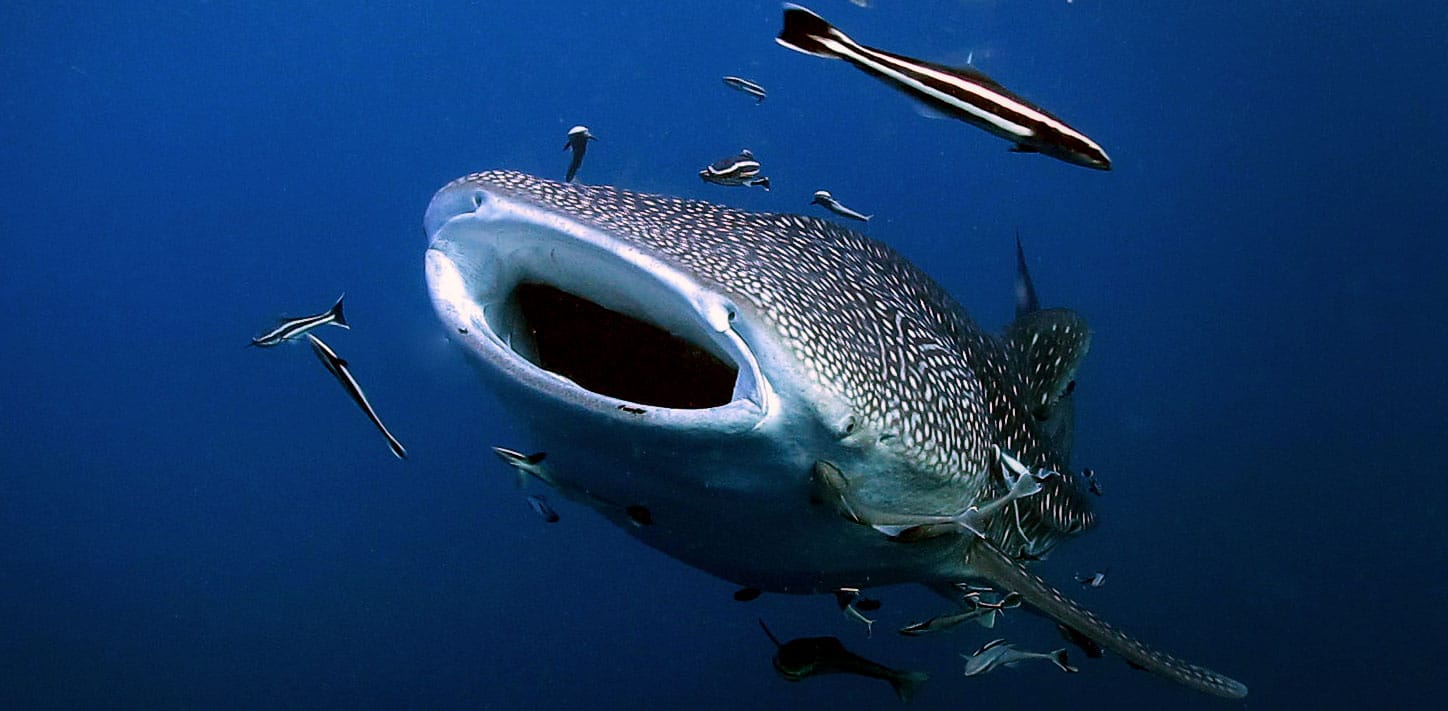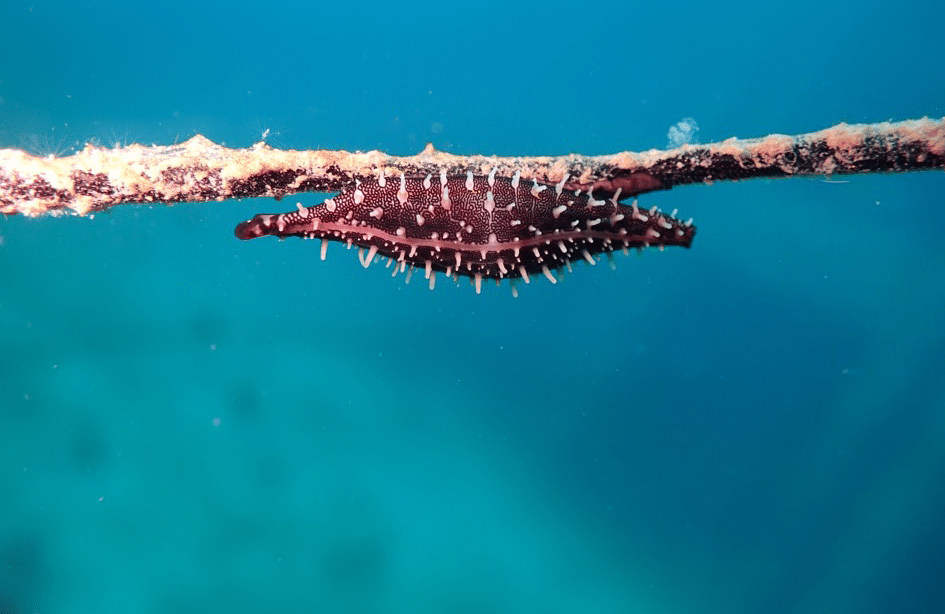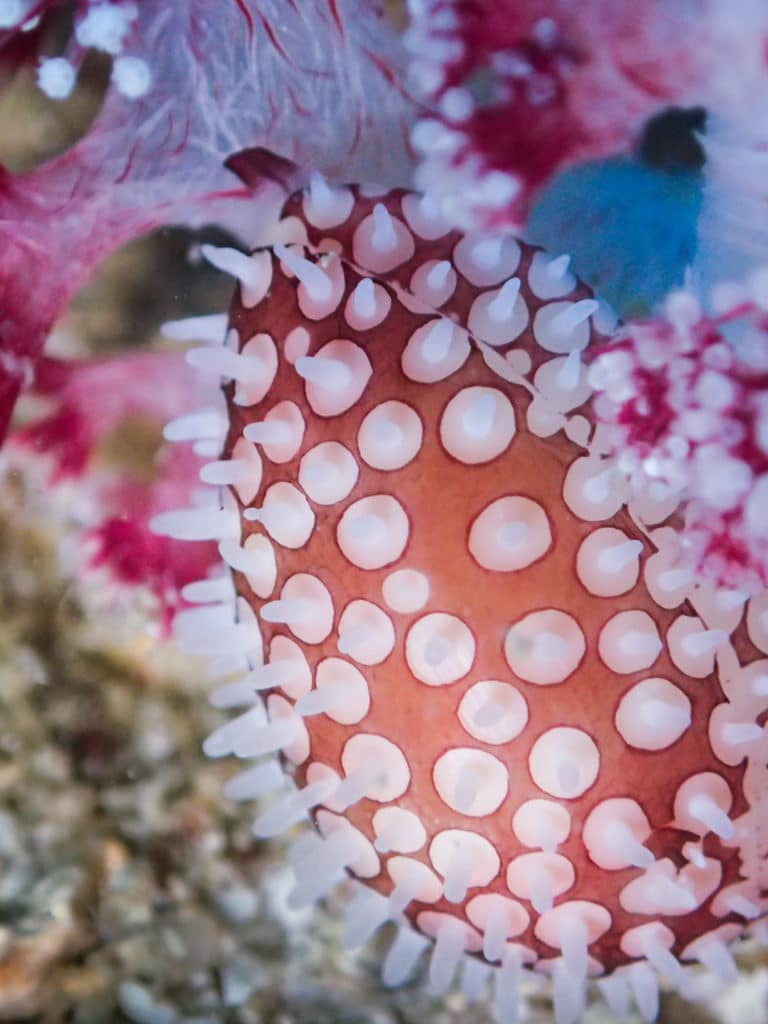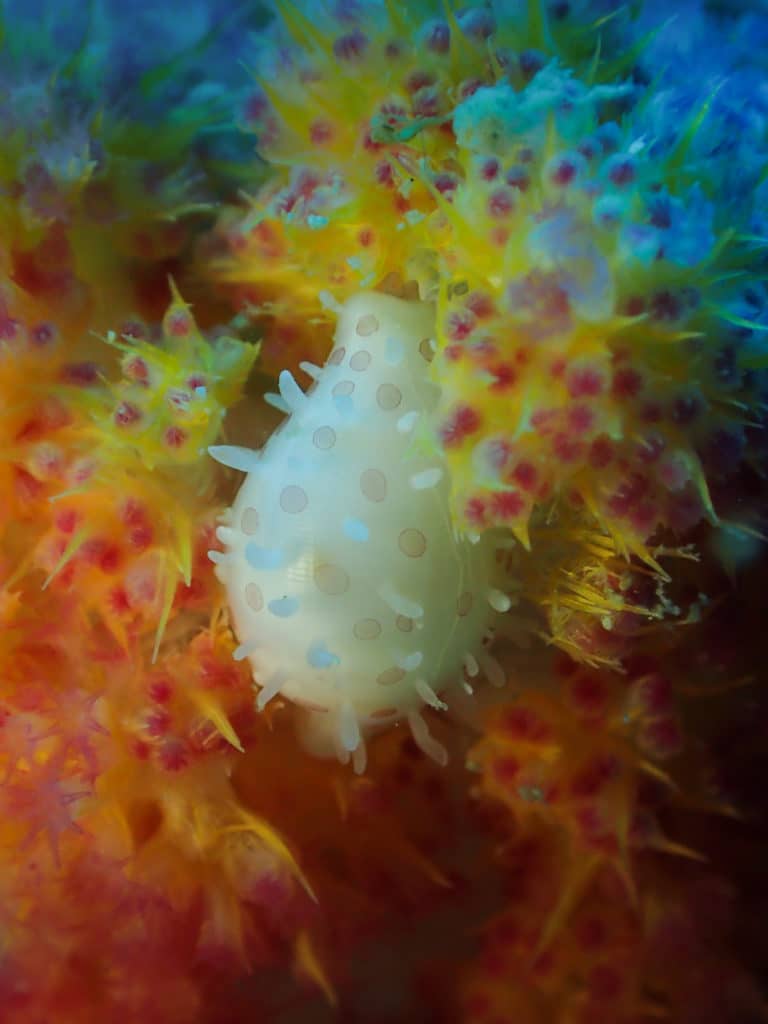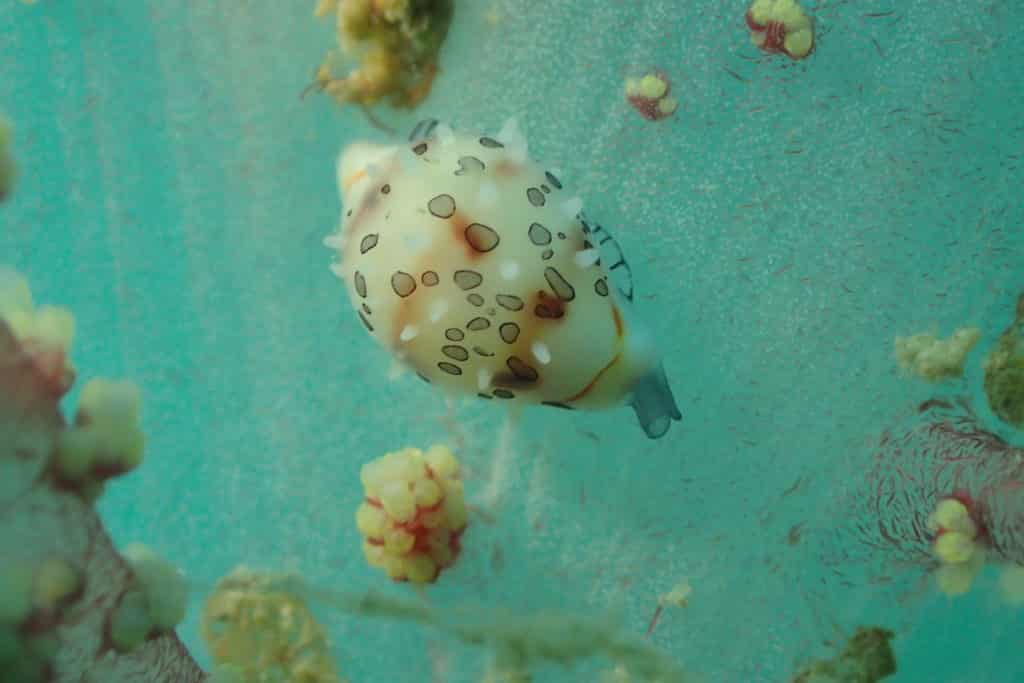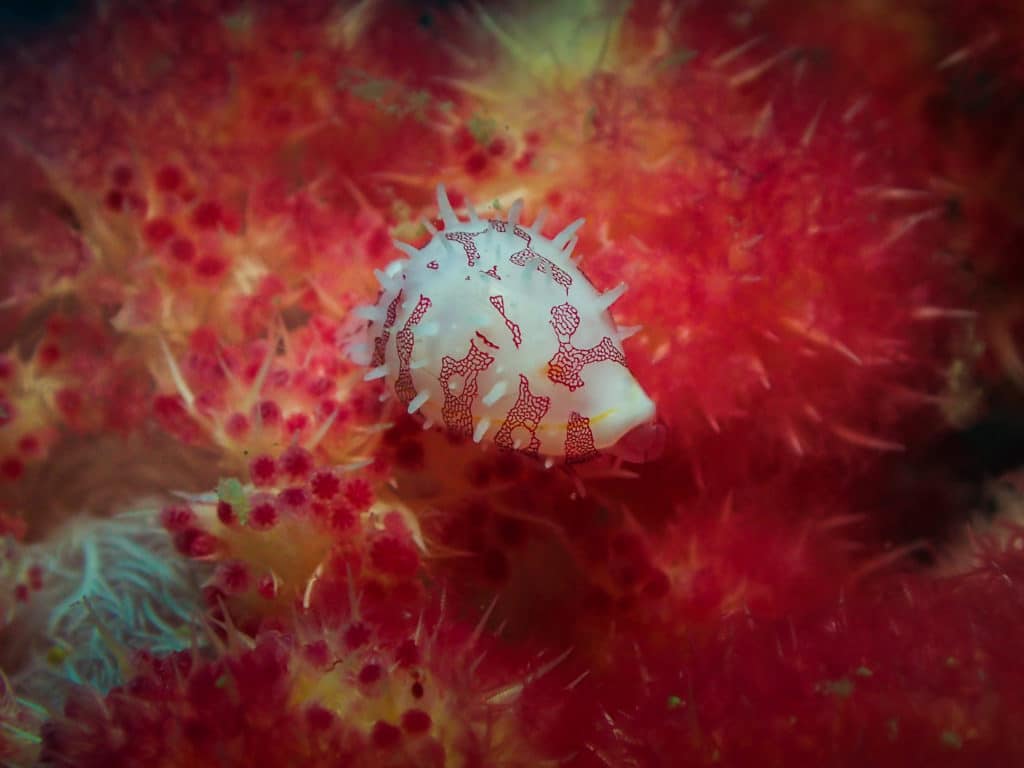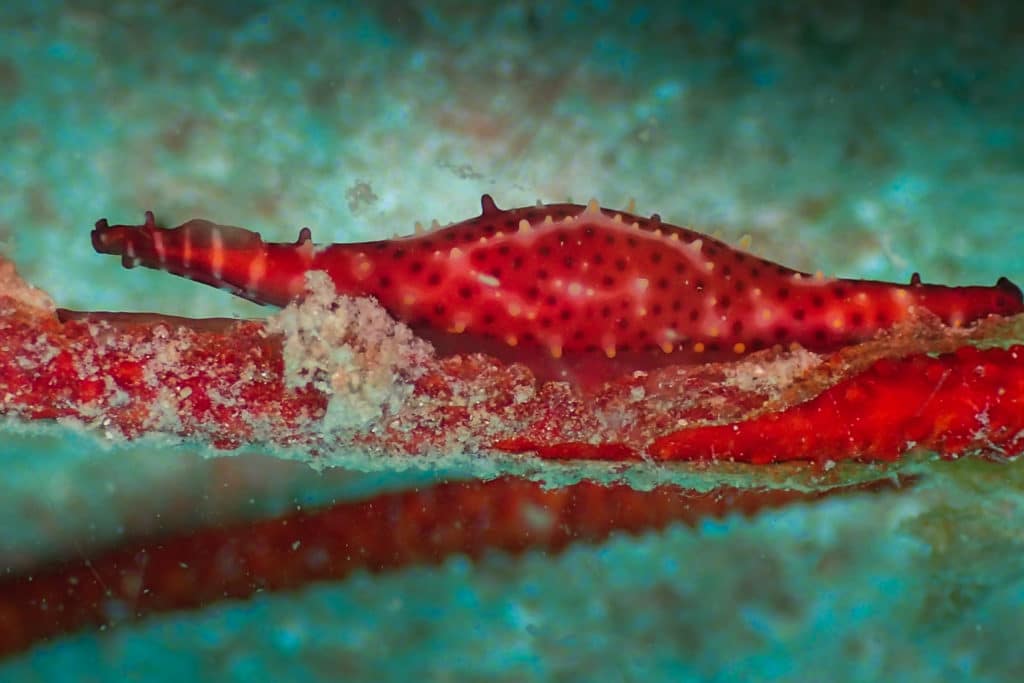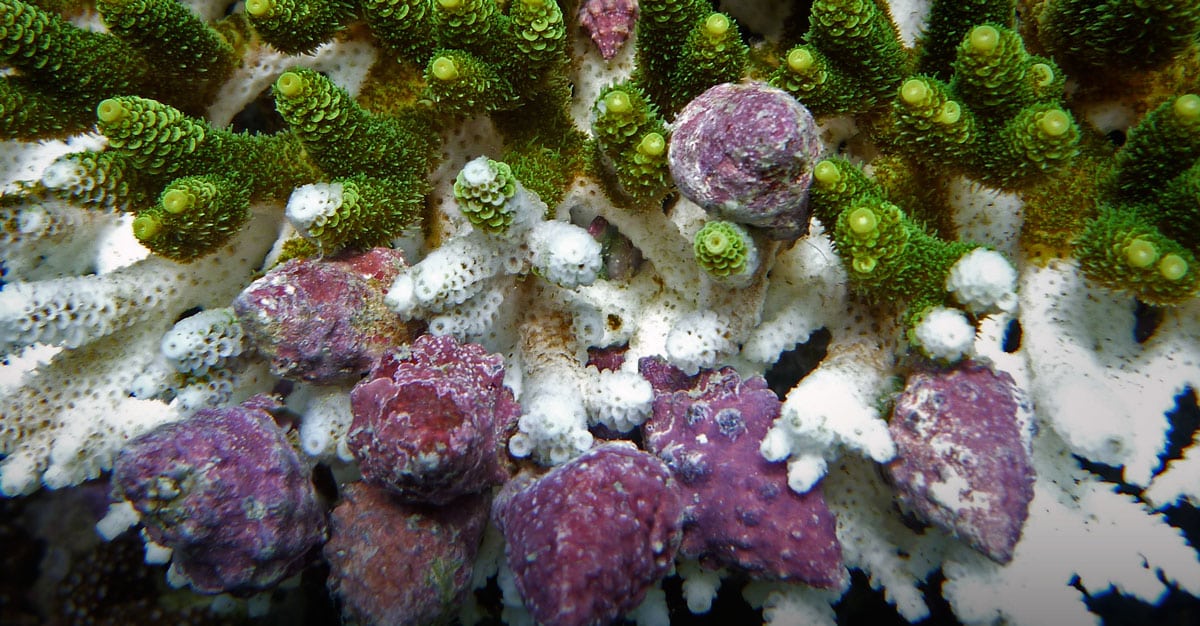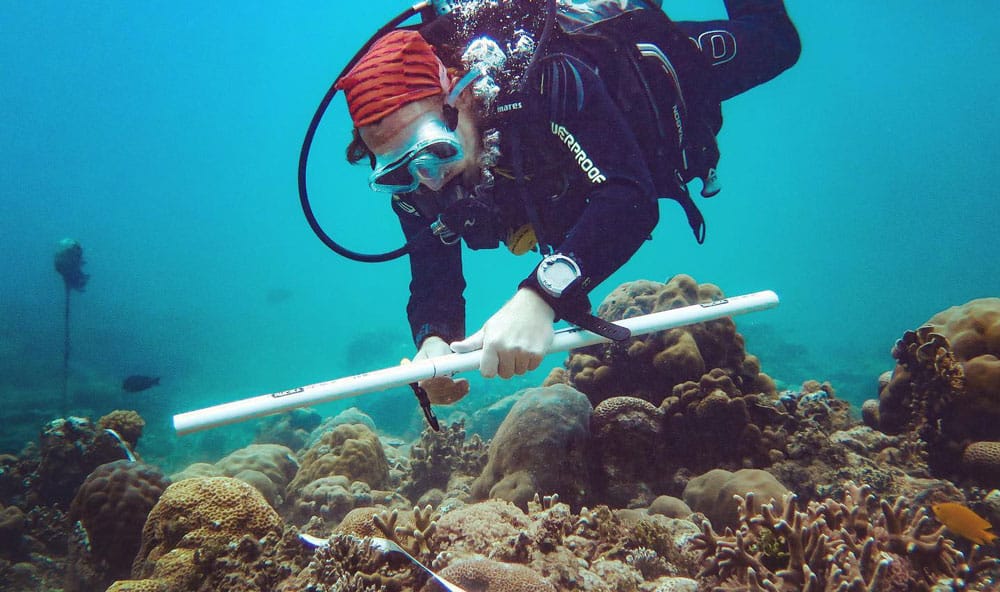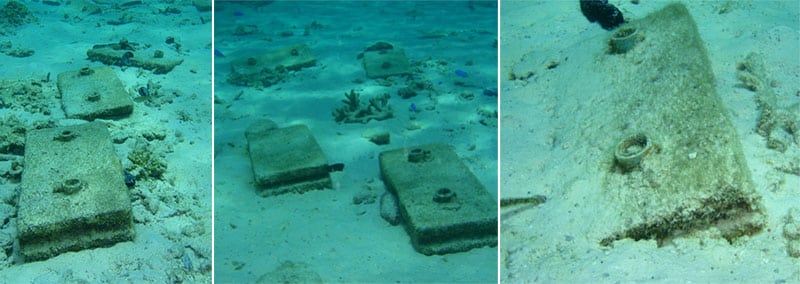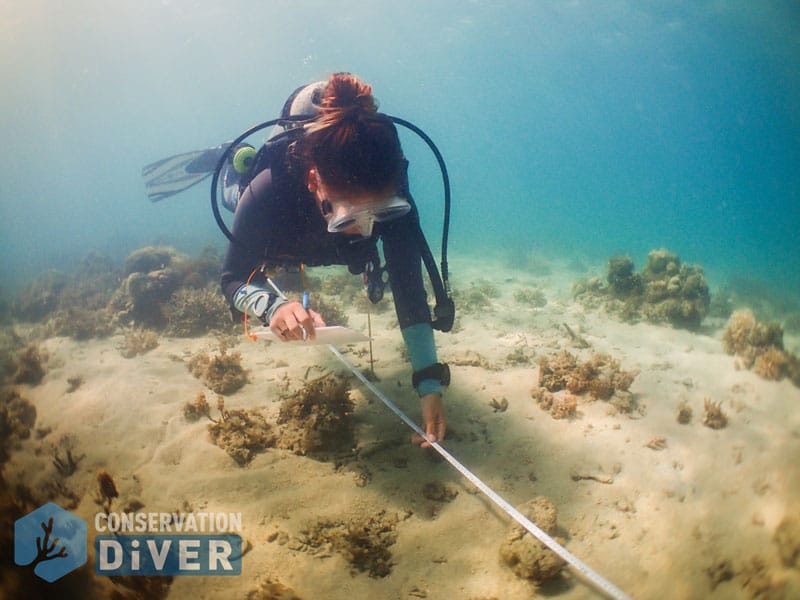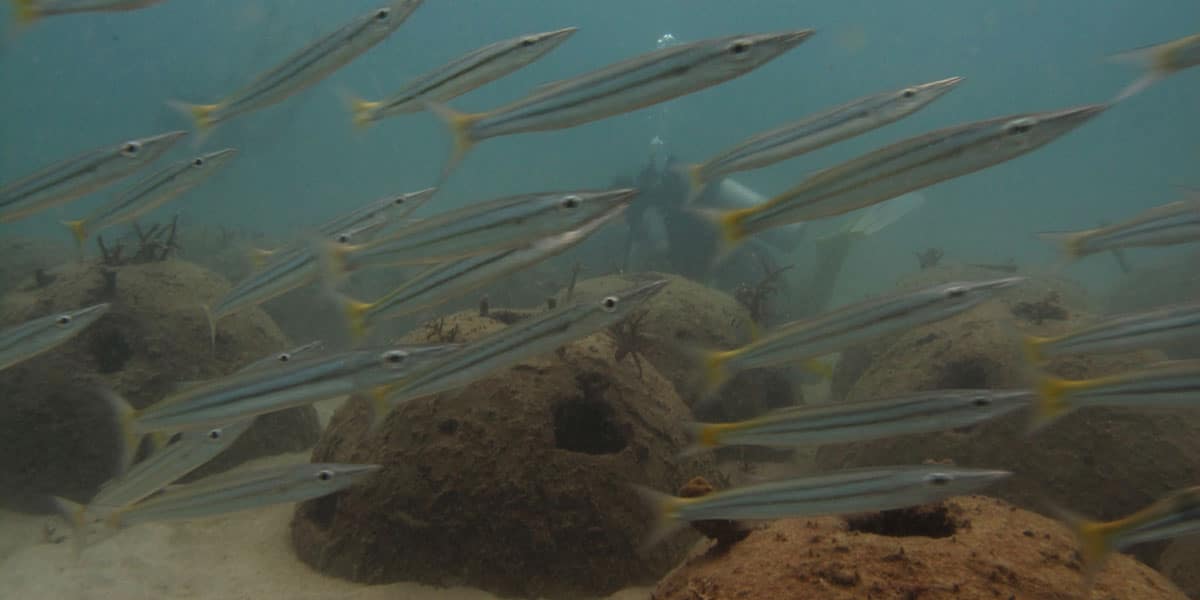Saving Thailand's Gentle Giants: How Divers Protect Whale Sharks
Swimming with the ocean’s largest fish is an experience that changes the lives of any diver lucky enough to have the encounter. Thailand's whale sharks bring in an untold number of visitors each year, but data shows their populations are declining.
Now, divers and other marine enthusiasts are actively helping professionals to understand and protect these gentle giants through photo databases. Anybody with a camera can capture images of the spot patterns of the whale sharks, which can then be used for identification, much like fingerprints. Groups like Thai Whale Sharks then use that data to track populations and inform local managers and policy-makers.
Whale sharks are found in warm waters worldwide, but their numbers are declining – they’re now classified as endangered. Threats to whale sharks include targeted fishing, accidental fishing (known as bycatch), boat collisions, and entanglement.
To protect these migratory animals, scientists need to understand better where they travel to and from and where they carry out various stages of their reproduction and development. But, collecting such data has historically been difficult and expensive.
That’s why Conservation Diver and partners have recently harnessed the power of citizen science to investigate populations of Thailand's whale sharks.
Here, we’ll bring you up to speed on citizen science, break down the collected data, and explain how it can help the conservation of whale sharks.

What is citizen science?
Citizen science is the science carried out voluntarily by members of the public. So, how can it be used to monitor whale shark populations?
Just like humans have their own individual fingerprints, whale sharks have their unique spot patterns. This means that photos of whale sharks can be used to assess whale shark numbers and monitor individuals over time.
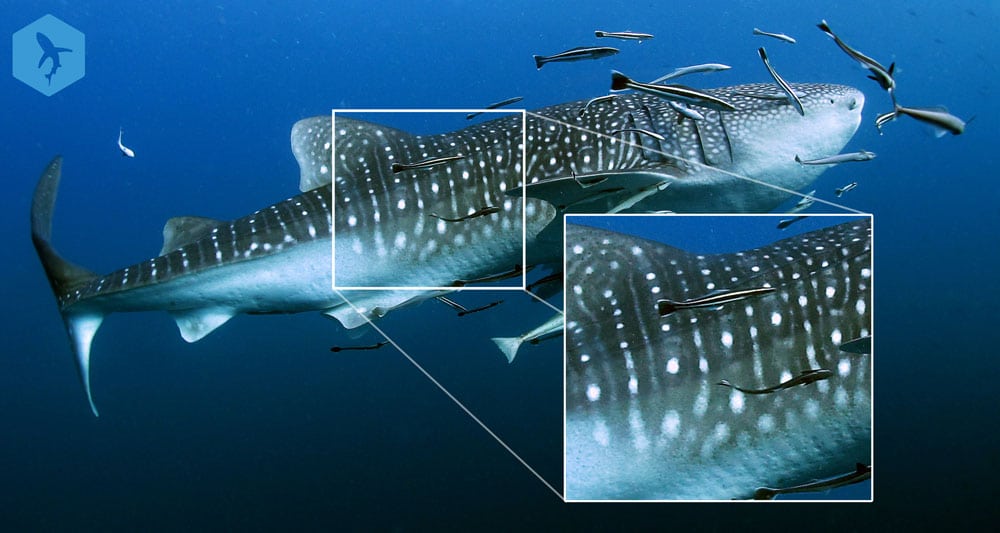
What’s more, whale sharks are incredibly popular among camera-wielding scuba divers. Cameras that are getting cheaper and better every year. Fortunately, this means that there are heaps of snaps of whale sharks out there.
Members of the public can then upload these whale shark photos to a photo-identification software library. This can tell us key information about the whale shark, like whether it’s male or female or even whether it’s been involved in a boat collision.
Moreover, if multiple photos of the same whale shark are submitted, we can learn even more about whale shark behavior. For instance, it’s possible to determine a whale shark’s annual migration patterns.
From 2004 to 2019, 247 whale shark sightings were recorded around the three islands of Koh Tao, Koh Samui and Koh Phangan to Koh Tao Whalesharks/Thai Whalesharks. Overall, 178 whale sharks were identified, and some individuals were spotted more than once.
From this data, Kirsty Magson of the New Heaven Reef Conservation Program and Conservation Diver led a team to publish a paper in the Journal of Fish Biology titled “Citizen Science Reveals the Population Structure and Seasonal Presence of Whale Sharks in the Gulf of Thailand.”
What did the study on Thailand's whale sharks show?
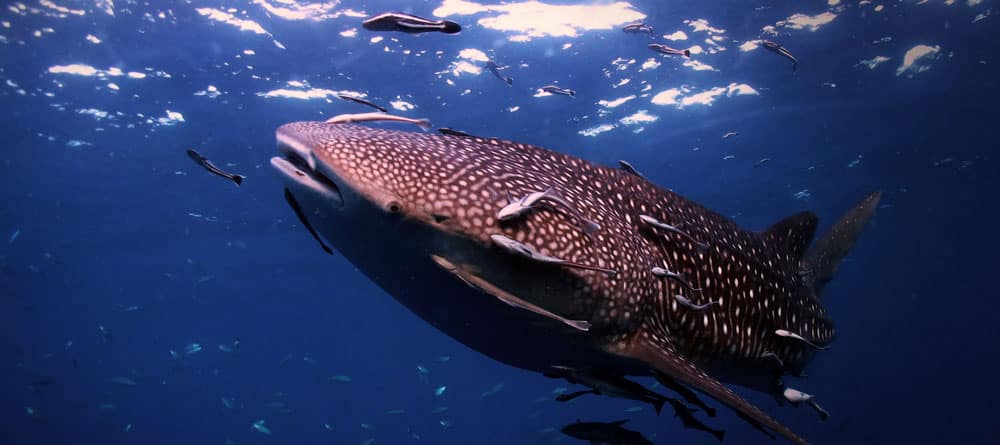
Whale shark size, sex, and scars
All the whale sharks sighted in the area were <6 meters long, making them juveniles. The average total length of whale sharks observed was 3.7 meters.
Sex was only reported for 27% of sightings; however, more female whale sharks were spotted than males (19% were female, and 8% were male).
Scars were reported for 28 individual whale sharks (16%). Fortunately, most of these, such as facial abrasions, were considered minor (79%).
Major scarring included loss of the dorsal fin. These were thought to have been caused by boat collisions and entanglement (for instance, in discarded fishing nets).

Whale shark movements and seasonality
The results highlight a peak in sightings of whale sharks in Thai water during April–May (35% of sightings) and another peak in October and November (23% of sightings).
Some whale sharks were sighted more than once, and one was in another country (Malaysia). The time between the initial sightings and resighting varied from less than one week to more than two years.
Statistical analysis of the data provided further insights. For instance, the whale shark population lost and gained members over time (known as an ‘open population’).
Additionally, some whale sharks showed signs of annual periodicity – this means that whale sharks returned to a site at regular intervals. However, all whale sharks eventually left their site completely.
Whale shark migration routes typically stretch for thousands of kilometers, and the researchers concluded that the monitored sites were used as a pit stop for whale sharks traveling long distances.
How can these data help to protect Thailand's whale sharks?
Of course, the data described here wasn’t generated in a laboratory and isn’t perfect. For instance, the peak sighting season of April to May coincides with a busy holiday period. This means that a great number of sightings could partly reflect a greater number of tourists with cameras in the area.
Nonetheless, these data provide some key insights that will help to plan further scientific investigations and, ultimately, protective policies.
For instance, most whale shark aggregations are formed mainly of males, but protecting juvenile female sharks is critical for population recovery.
Here, more females than males were sighted (at a 2:1 ratio). Therefore, these data provide further evidence of the need to protect the female-heavy whale shark population that frequents the Gulf of Thailand.
Additionally, 24 of the sighted whale sharks in Thailand were scarred or injured, including missing dorsal fins and rope tied around their tail. Rope often becomes entangled around whale shark tails when ropes are used to drag whale sharks out of nets.
It’s encouraging that whale sharks are being released. However, these observations indicate that part of the rope may remain attached to the shark, causing long-term injury or disadvantaging the individual.
Therefore, these data highlight the need for improved methods of releasing caught whale sharks.
How can I help?
The great news is that anyone can contribute to this research! All you need to do is upload your snaps to the Whaleshark Project (global) or the Thai Whale Sharks Facebook Page (Thailand) after you’ve been swimming with whale sharks.

The database uses technology similar to facial recognition to match the individual to the ones featured in previously submitted photos. If no matches exist, a whole new profile will be generated for that individual.
The website also features a super handy code of conduct for Thailand's whale shark diving – check it out so you can ensure you act responsibly when encountering one of these majestic creatures.
If you’re keen to dive a little deeper into the study's findings, you can find the original article here.
Proactive & Reactive Ecosystem Restoration
Proactive and reactive ecosystem restoration are two new terms that more accurately define what is actually happening in the real world. They are replacing the old terms of passive and active ecosystem restoration. The two modes were broadly defined in terms of where the human energy and resources were put in the hopes of bringing back ecosystem health and function.
In passive restoration, the energy was put into stopping the threat and letting the ecosystem recover independently. In active restoration, our energy and resources assisted or facilitated the ecosystem's recovery more directly. These terms were always a bit ambiguous and poorly conveyed the nuance and complexity of the actions being performed by managers.
In a new paper by Hein et al., 2021, the authors discuss this issue and propose using new terms to describe these two restoration branches as they pertain to coral reefs. They introduce the term ‘proactive’ to replace passive, and ‘reactive’ to replace active restoration. These terms more accurately describe the actions being taken and may make communicating the details of these projects more precise and relatable. We at Conservation Diver will be switching up our terminology in support of this, and here is why we think you should too.
Passive and Active Coral Restoration
For decades, the prevailing opinion and policy of reef managers were that protection is always preferred over restoration. By stopping the threats to the ecosystem, the flora and fauna would rebound independently without further human intervention. From this came the term ‘passive restoration,’ meaning that no time, energy or resources were put into the ecosystem to return its health, diversity and function.
However, this term implies that nothing is being done when in fact stopping the threat is anything except “passive.”

For example, Tanote Bay on the island of Koh Tao, Thailand, was one of the more beautiful and vibrant reefs in the entire region. In 2006, the municipal government constructed a large reservoir above the bay to address the island’s unstable freshwater resources.
This was accomplished through massive deforestation, road cutting, and digging on the highest peak in the bay's watershed. By 2008, millions of tons of sand and clay had been washed into the bay, burying the reef under 1-2 meters of sediment. The coral reef was literally gone, and the water quality was extremely poor as more sediment loaded the area with each rain.
In 2008, we worked with the New Heaven Reef Conservation Program, the Save Koh Tao Community Group, and many community volunteers to ‘passively’ restore the bay by stopping erosion and sedimentation.
This included planting hundreds of thousands of Vetiver grass tillers and trees; constructing over a hundred check dams, and installing hundreds of erosion control logs and blankets: all of which took more than three years. In our minds, it was anything except passive, as the word is used in everyday language. However, since we were not working in the coral reef itself, that was how it was defined.

In the same way, the word ‘active restoration’ never really encompassed what managers were doing or moving towards in their techniques and methods. As Hein et al. point out: in the past, restoration was thought of as the act of bringing the ecosystem back to its historical state. However, bringing ecosystems back to their historical state will not be possible in the face of the increased effects of climate change.
Instead, the focus must shift from maintaining historical species to maintaining the “key ecosystem processes, functions, and services through the next few decades of climate change.”
Proactive and Reactive Ecosystem Restoration
The authors (Hein et al., 2021) propose the two new terms as a way to clarify the actions being done and the intent behind them in the context of a rapidly changing planet.
Proactive restoration would thus refer to any act or initiative aimed at “protecting and enabling recovery.” These proactive measures then go on to support the reactive measures “aimed at repairing ecosystem function and assisting the recovery of a degraded reef system, should it not be able to recover on its own.”
With this new, more accurate terminology, the things we do to protect the ecosystem (such as erosion control, wastewater treatment, and mooring buoy installations) are considered proactive measures. These are things done primarily on adjacent ecosystems to help facilitate recovery within the target ecosystem.
In some cases, like when there is still available structure and high larval supply, this can be all that is required to return the ecosystem services and function. And even in situations where those factors are not present, it is still the prerequisite for most successful reactive projects down the line.
Reactive projects in coral restoration would include coral gardening, artificial reefs, larval culturing, and all the other projects reef managers implement as part of a successful holistic program. These are the actions taken to increase the health, abundance, and diversity of key reef species or improve their resilience and help them adapt to changing conditions. The authors of the report developed this graphic to help visualize the actions taken under each mode of coral restoration:
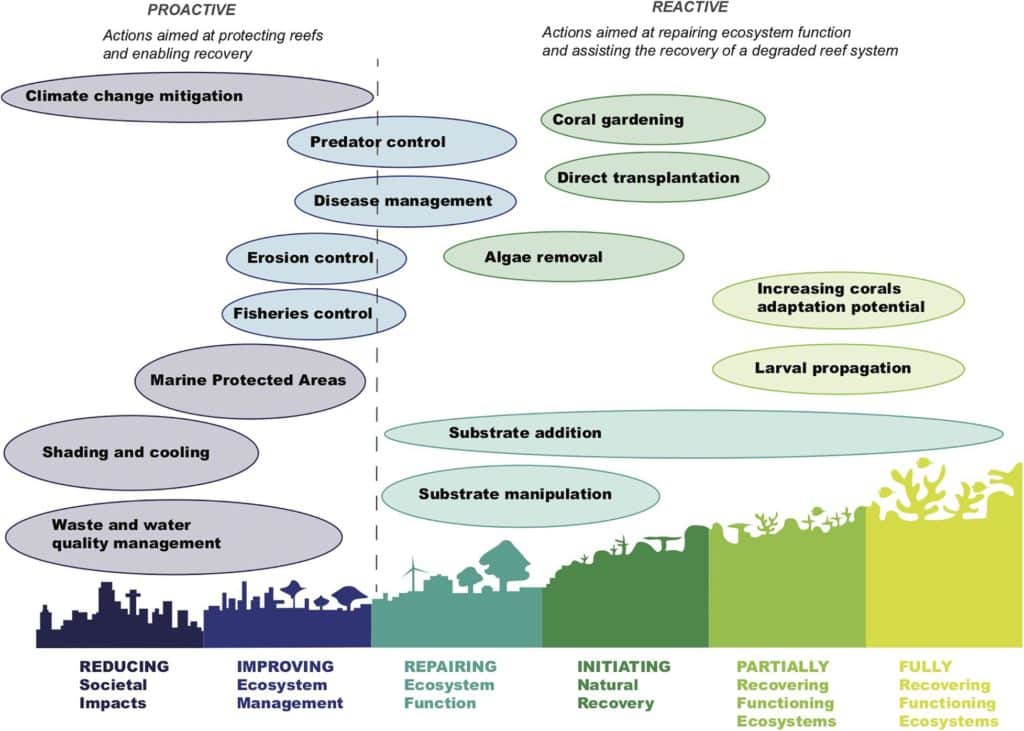
The coral restoration industry is still in its infancy but is one that is becoming more urgently necessary with reefs around the world in rapid decline.
While we work to solve the issues leading to climate change, we must be proactive and reactive in our efforts to preserve ecosystem value and function. These new terms help to show not only the effort and planning that has to go into what was once called passive restoration but also open up what was active restoration to include the work being done to build resilience and assist in the adaptation of corals through breeding programs. This is only one minor point that this vital report brought up, so stay tuned as we dive deeper into its recommendations and implications.
Amid the Ovulids: True and False Cowries
Seashells such as ovulids and cowries are two which are often misidentified for each other. Ornamental patterns and colours are typical, and they possess mantles which extend over their shells, often providing a brilliantly texturized, nearly alien-esque appearance. Both play seperate ecological roles, and are sought after for their aesthetics amongst ocean photographers.
Today, we will be using Cowries for comparative purposes, but focus mostly instead, on their cooler cousins. The False-Cowries, or Ovulids, are a striking and diverse family of shells that are easy to mistake for the common Cowrie- many common names even include ‘cowrie’ in the title; spindle cowrie (Phenacovolva rosea) is one example. Luckily, there are morphological and ecological indicators to help us distinguish these two frequently muddled gastropods.
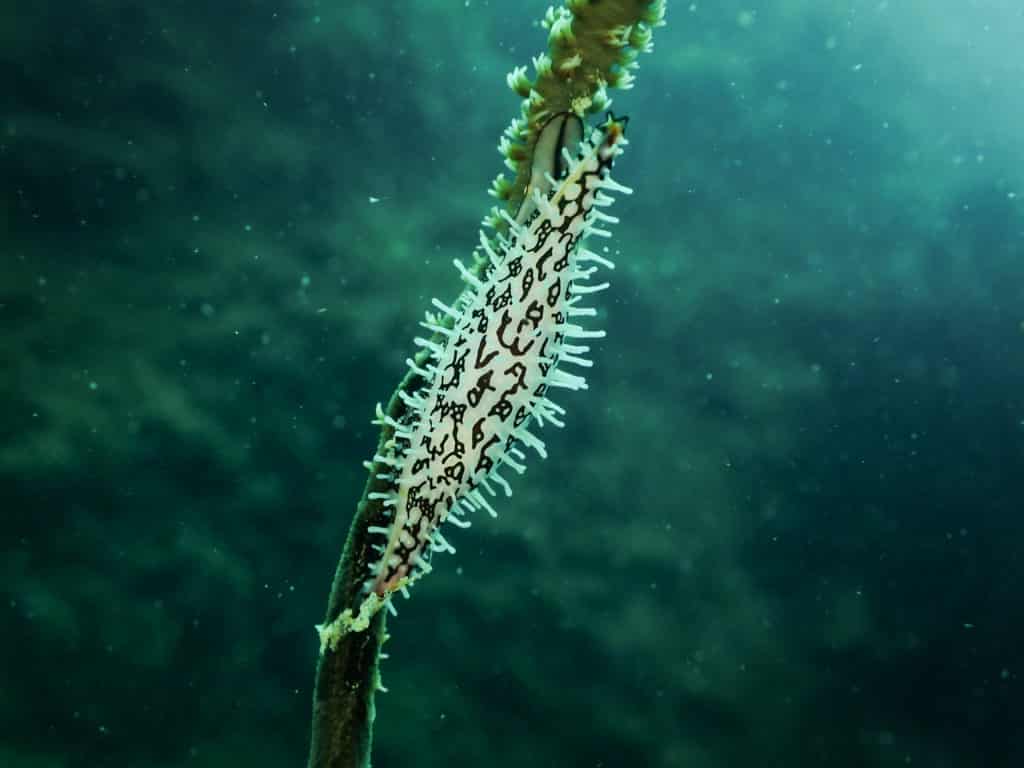
Ovulids vs Cowries
The Ovulids, or Ovulidae are a family of gastropods descending from the super family Cypraeoidea (not to be confused with the Cypraeidae- the family which contains the true cowries). Both families are closely related and are spread across most marine habitats.
They have an astounding range of shell designs and mantles (the tissue which extends over the shell for maintenance and feeding). The simplest way to tell the two apart are by comparing the general shape. Cowries are globular and generally remain consistent in shape amongst species. Ovulids on the other hand are varied in colour and pattern, are more elongate, and overall have more variation to their shape than the common cowrie shells- to some degree, they are even able to change their morphology to suit their habitat (Rosenberg 1992). Looking underneath, cowries are distinguishable by inward rolling ‘lips’ on both sides of the shell, while ovulids have only a single lip on one side (Schmidt-Kittler, Norbert Vogel 2012). Ovulids are easily mistaken for sea slugs when their protective mantle is fully extended, due to their often brightly ornamented nature. Both however, are aesthetic organisms which grace our marine habitats and excite macro photographers globally.
Ovulid vs Cowrie Diet
True cowries are bottom dwellers, whos diets include soft corals, sponges, anemones and sometimes algae in their younger stages. Ovulid diets are surprisingly different, consisting of soft coral, sea pens, gorgonians and many other Octocorallia species. Additionally, in the Indo-Pacific, there have been records of them feeding on Antipatharia species (often nicknamed ‘black corals’ (Reijnen et al. 2010). At our Koh Tao Conservation Diver centre, New Heaven Reef Conservation Program, we make notably more observations of these cowrie-allies at deeper sites, such as muck ecosystems over coral dominated ones (hail the muck habitat!). They can often be found in deep sandy areas that have a diverse range of sessile community (the non-moving bottom community).
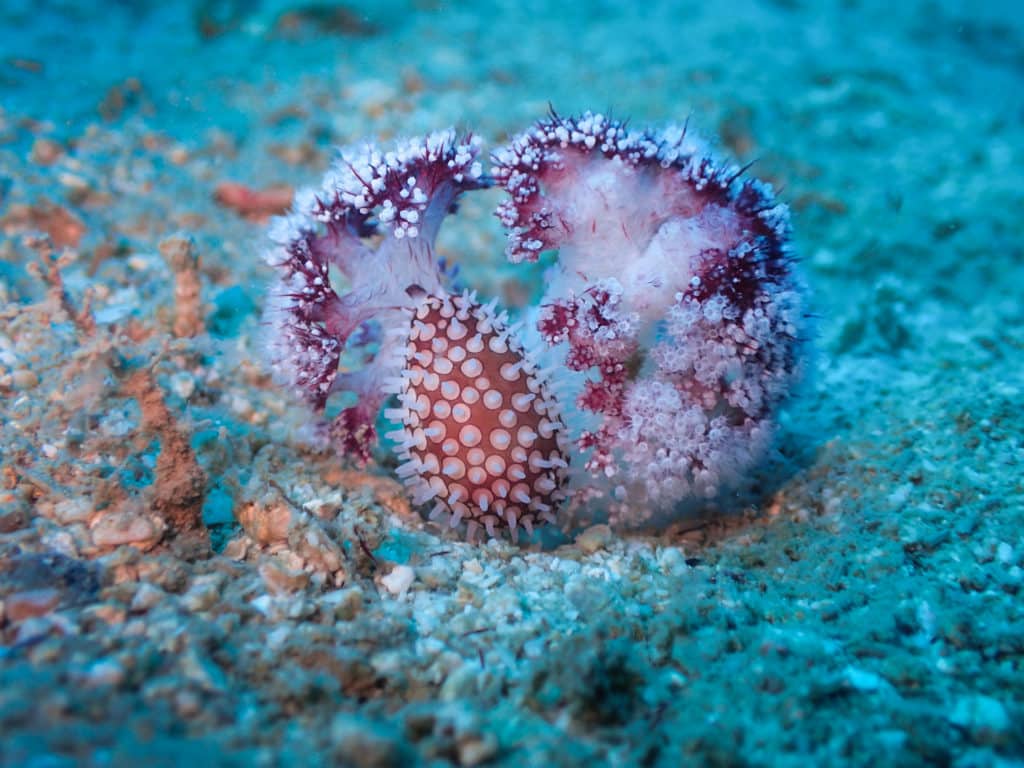
Ovulids are ectoparasites, which means that they live on their food source, using it as habitat and a backdrop. Remarkably, they attain alimentary homochromy, where they change colour by the incorporation of pigments from their food, and to some degree are thought to be able to control their size and shape depending on their host. This facilitates better camouflage to their environment and food source, as well as a colourful warning to potential predators of unpalatability (Reijnen et al. 2010).
What Ovulids have we found on Koh Tao?
- Priminovula brevis: Among the larger of the ovulids seen on Koh Tao, P. brevis can be found exclusively upon Dendronepthya spp. corals in the muck.
-
Priminovula brevis -
Diminovula cf. aurantiomacula
- Diminovula cf. aurantiomacula: The most abundant of the ovulid species observed at Koh Tao, exclusively found directly upon Dendronepthya spp. corals in the muck.
- Diminovula cf. margarita: Sometimes abundant, often found alongside D. cf. aurantiomacula, exclusively found directly upon Dendronepthya spp. corals in the muck.
-
Diminovula cf. margarita -
Diminovula culmen
- Diminovula culmen: The least likely of this genus to be found at Koh Tao, D. culmen can be recognised by its patchy, camouflage-patterned mantle colouration. They can be found upon the Dendronepthya spp. soft corals in the muck.
- Naviculavolva deflexa: Another rarity, N. deflexa is separated from the species discussed so far in having developed an elongated shape, stretching from a globular form to one resembling the more spindle shape of later species. Interestingly, the mantle of the species is white, with a thin margin of orange/red in its anterior portion, giving this shell a naked appearance. This is also the first of the species that may be observed closer to the reef/reef edge, feeding on the octocoral Rumphella sp..
-
Naviculavolva deflexa -
Phenacovolva cf. nectarea/rosea:
- Phenacovolva cf. nectarea/rosea: This species is known under one of two names that are likely the same species (awaiting nerdy people to get their act together). It is part of the true ‘spindle cowrie’ ovulids representing the largest of the species found at Koh Tao. Their elongated shapes are covered in a mantle that can range from pale pink through red and deep purple and is ornamented with short rounded papillae that are the same colour and others that are bright yellow. This species has been observed on numerous different octocorals including Dendronepthya spp., Echinogorgia spp., Ellisella spp. and Solenocaulon spp.
- Phenacovolva sp.: A currently unidentified member of the genus Phenacovolva, this is the second, rare species of true ‘spindle cowrie’ ovulid found in the waters of Koh Tao. It is differentiated from the previous species in having a dark reticulated pattern on its mantle and being ornamented with numerous pointed white papillae. So far, they have only been found on Antipatharia spp. (whip corals).

References
Reijnen, B. T., B. W. Hoeksema, and E. Gittenberger. 2010. Host specificity and phylogenetic relationships among Atlantic Ovulidae (Mollusca: Gastropoda). Contributions to Zoology 79:69–78.
Rosenberg, G. 1992. An introduction to the Ovulidae ( Gastropoda : Cypraeacea ) 20:4–7.
Schmidt-Kittler, Norbert Vogel, K. 2012. Constructional Morphology and Evolution. Springer-Verlag, Berlin Heidelberg.
Photos provided by Dr Rahul Mehrotra and Elouise Haskin, but mostly Rahul.
Understanding Corallivorous Drupella Snails
Although outbreaks of corallivorous Drupella snails have been increasing across the Indo-Pacific since the 1980s, still very little is known about their reproductive ecology. These tiny snails can occur in great abundance and can contribute to reef decline by lowering the total abundance of living coral and changing the population structure of reef communities.

Tracking these Coral Predators
Conservation Diver has been focusing on Drupellas for some time, with our first observation of the snails shifting their preferred food sources following the global mass coral bleaching event of 2010. Since then, our partners at the New Heaven Reef Conservation Program have collected more than 179,740 Drupella snails from around the island of Koh Tao, with 76% coming from a single bay.
In 2019, a team of our Conservation Diver Trainers traveled to Mauritius for a collaborative research expedition with the University of Mauritius. They were pleased to apply their Drupella snail knowledge to the local reefs and assist published Drupella snail researcher Deepeeka Kaullysing, in recording observations from the area. During their biodiversity surveys, primarily focused on heterobranchs, they noticed a significant deposition of egg masses under mushroom corals in the vicinity of a large Drupella aggregation. Upon closer inspection, they realized they were looking at the largest concentration of Drupella egg clusters ever recorded.
Although the first outbreak of Drupella snails was recorded in the early 1980s, much of what we understand about their life history is derived from similar organisms. Very few publications detail observations of the egg or larval stage of these predators, which is vital to know to mitigate the damage caused by over-populations or outbreaks.
Understanding Drupella Lifecycles
The first recorded Drupella egg deposition was published by Sam et al. in 2016 in an aquarium. This was followed quickly by the first in situ observation in 2017 by Scott et al. and was also the first record of egg deposition on the underside of Fungiidae corals.

The recent Kaullysing et al. (2020) publication is the first record of Drupella egg deposition in Mauritius and the Western Indian Ocean. Additionally, this is the first record of in situ egg deposition on corals other than Fungia. This time, eggs were observed on Fungia, Montipora, and the shell of another Drupella snail.
Furthermore, it represents the highest abundance of corallivorous Drupella eggs ever observed, with 5,020 egg bundles on a single coral (each bundle contained approximately 96 embryos).
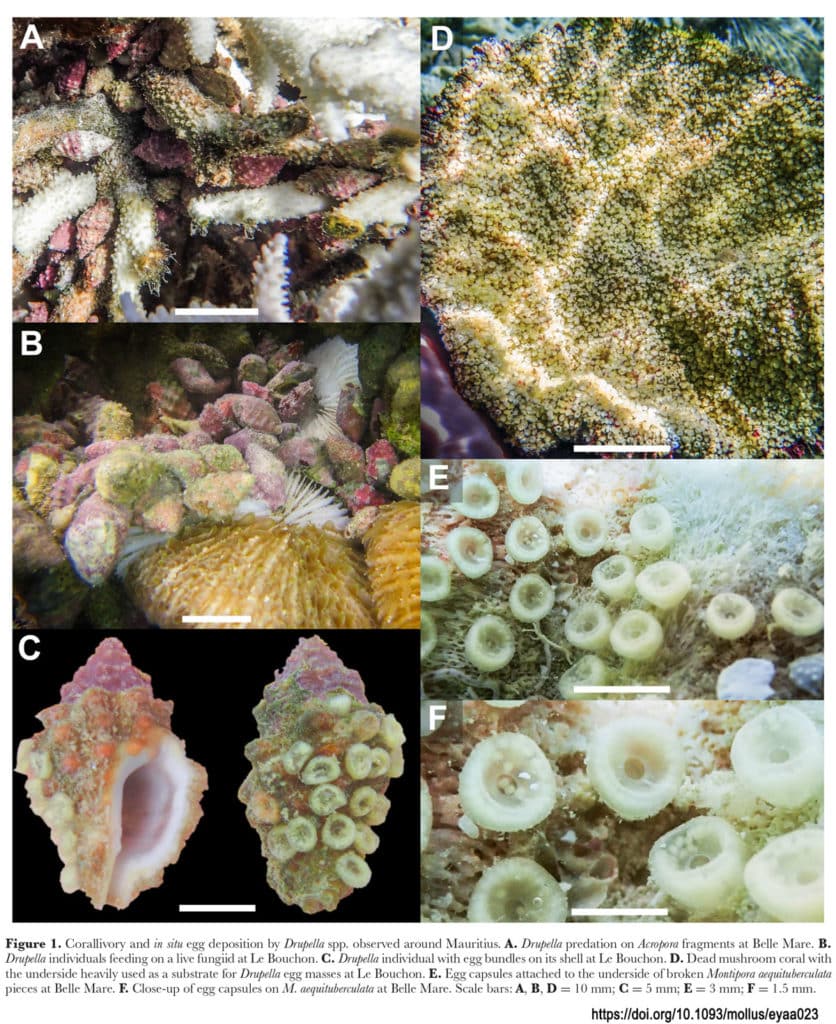
Observations such as these are vital to the understanding of the ecology and life history of these cryptic species. Only 40 years ago, they were essentially unheard of, yet today they are seen as one of the Indo-Pacific's significant problematic coral predators.
Stopping Outbreaks of Drupella
To halt outbreaks and mitigate their damage, reef managers must understand the details of their life history. By targeting benthic egg cases for removal rather than the adults, much time and resources could be saved.
The program on Koh Tao has been working for a decade to remove nearly 180,000 adult snails, whereas removing just the observed corals in Mauritius could potentially prevent the dispersal of 1.6 million embryos (4 corals x 5,000 egg bundles each x 80 embryos per egg bundle).
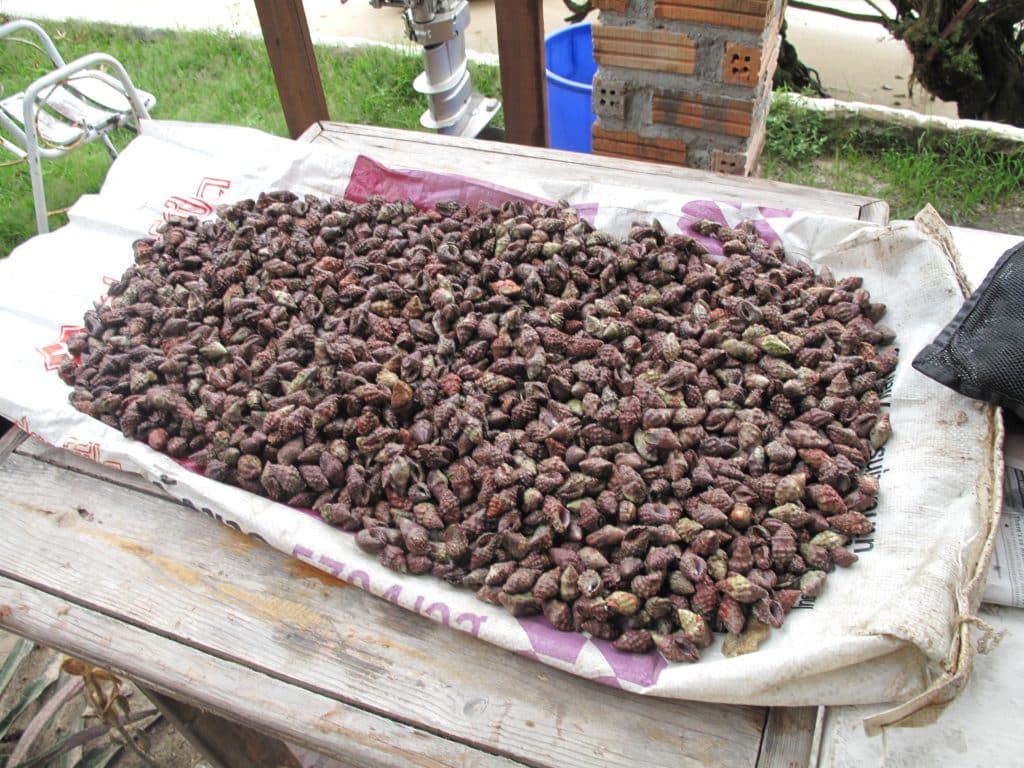
This is a very important publication for the advancement of this field and surely will be one of the stones placed on the path to better understanding and management guidelines for these pervasive coral predators. We wish our sincerest gratitude and congratulations to all of the authors, but especially those on the Conservation Diver team; Rahul Mehrotra, Spencer Arnold, Alyssa Allchurch, and Elouise Haskin.
Be sure to check out the paper here
A New Record of Heliopora Coral
Until recently, it was thought that the genus Heliopora was monotypic, with the only species described as Heliopora coerulea. However, that is quickly changing, and the Conservation Diver team is helping to increase records around the Indo-Pacific. Our finding represents the second hermatypic octocoral we have discovered in previously unknown locations, after Pau Urgell found the very rare coral Nanipora on Koh Tao in 2014.

A Reef-Building Soft Coral
Heliopora is an octocoral (mostly soft, non-reef building) however it is hermatypic, meaning that it is a reef builder. This genus is unique in that the skeleton has a blue coloration derived from the iron salts in its fibrous aragonite matrix.
This species can be traced back more than 120 million years to the Cretaceous Era and has remained mostly unchanged since. It was only in 2018 that the first records of a second species of Heliopora (H. hiberniana) was described, and only from 3 locations in Western Australia. But even then, it was hypothesized that this cryptic species could be more widespread.
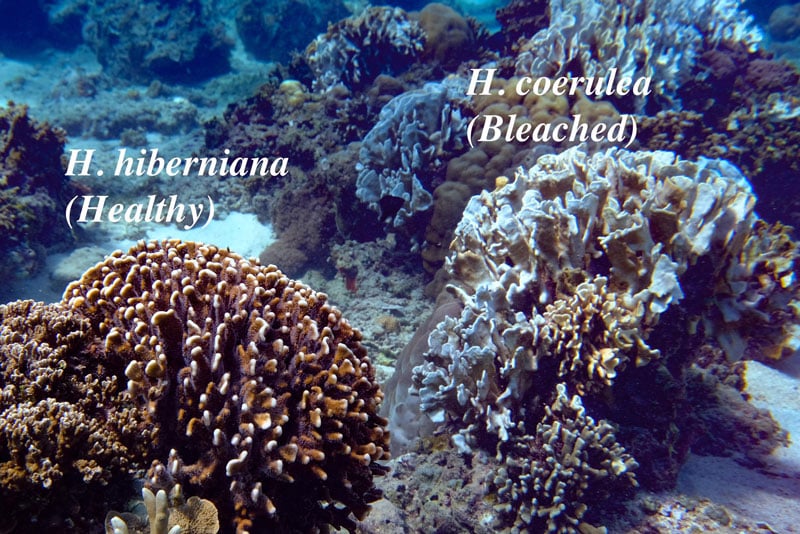
Whilst working on coral nurseries in the Maldives, Conservation Diver Board Member and head of Conservation Diver Indonesia, Leon Haines noticed a Heliopora colony that did not match any seen in the guide books.
After a quick online search, he stumbled upon the newly described species and contacted the scientists with a photo to confirm his suspicions. Indeed, it was a colony of H. hiberniana over 6000 km from the area it was originally described to science!
After his time in the Maldives, Leon returned to Indonesia where he subsequently noticed H. hiberniana to actually be one of the most common reef-building corals in the Gili Islands! After working with other researchers, he published the first record of H. hiberniana outside of Australia, this time both in the Baa Atoll, Maldives, and the Gili Islands of Indonesia.
Heliopora on Future Reefs
This is a significant find, as in the future, non-scleractinian hermatypic corals may be forced to play a more prominent role in sustaining the structure of coral reefs around the globe.
These octocorals seem to be less susceptible to warming climates and coral bleaching events and may provide an alternative structure to the historic hard coral species which built them. These records are also vital to tracking the effects of climate change as the historic home ranges of various species are altered due to changing ocean conditions and can help us to predict where conservation and protection efforts will be the most effective.
We extend our sincerest congratulations to Leon for this publication and are excited to see how we can contribute to the development of the understanding of this species in the future.
Reef Restoration Techniques: The Bottle Units
The Bottle Units are a reef restoration tool utilized by all Conservations Diver Training centers, and originally developed in 2009 at our center on Koh Tao, Thailand, the New Heaven Reef Conservation Center. The units were originally developed by two of our students, James and Ames, and have been tested and refined over the years since. This cost-effective method at reef restoration is easy to build and deploy, and is highly effective at increase the available substrate for transplanting corals when restoring reef areas or creating new structure to extend the reef area and establish alternative dive training locations.
To download the PDF version of this article, click here
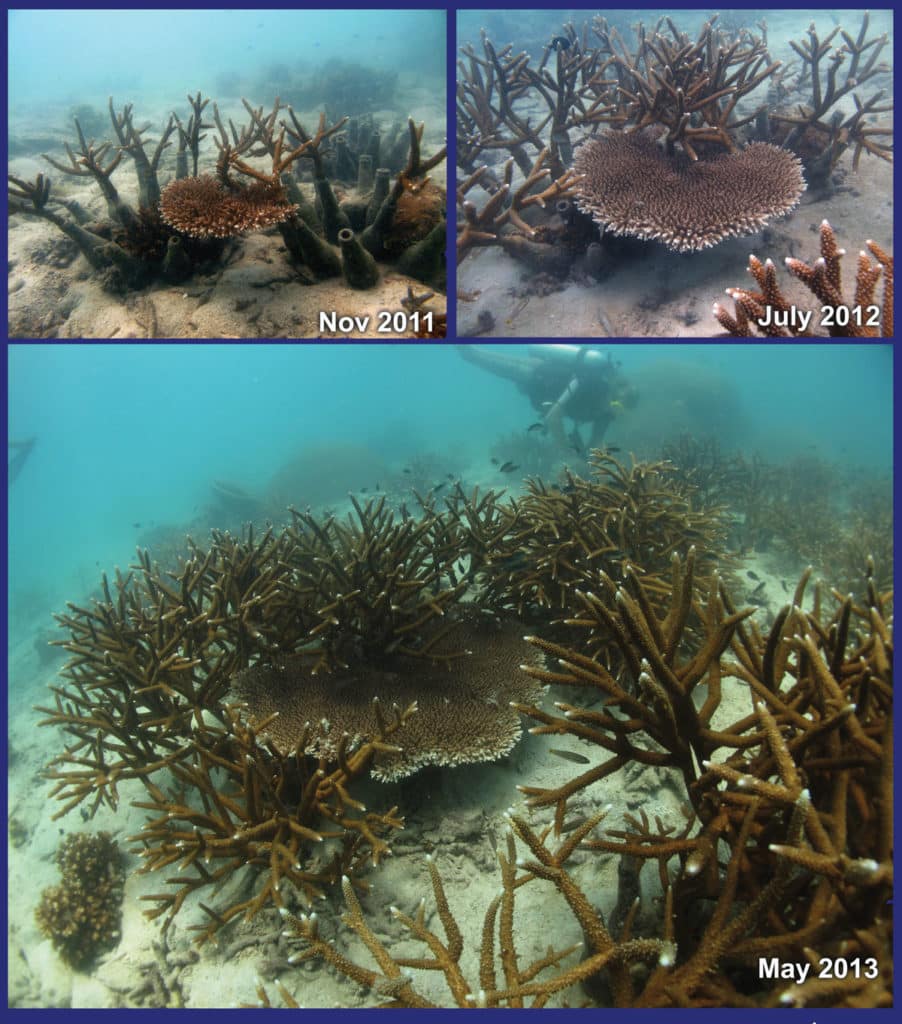
Objectives/Purpose
The Bottle units are well suited for adding stable growing structure for the transplantation of both nursery-raised and so called “corals of opportunity,” in the process of restoring coral reefs. The units are especially applicable in areas that have experienced anchor damage, dynamite fishing, boat groundings, and other acute forms of structural damage. By being simple to build and easy to deploy, the units lend themselves to easy scalability and widespread use. They use materials that are cheap and easy to source anywhere in the world, and can be quickly constructed and deployed as a rapid response measure following disturbances to reef health.

The units are heavy enough to provide a secure transplant location
for coral feedstocks, but are still light enough to deploy using only basic
SCUBA and marine conservation equipment. After deployment, the units raise the transplanted
corals to a height up to 50 cm from the bottom, allowing them respite from many
threats, and providing them with ideal growing conditions. The units are structurally
complex, creating habitat for many other organisms which are essential for
restoring the ecosystem, rather than just increasing the coral abundance.
The units will last several decades, and are generally covered in corals relatively quickly. The materials used are non-toxic, and conducive to coral growth. In many island settings where glass bottle waste is a problem, they are also a form of repurposing. Because of the simplicity and artistic freedom available in construction, they are a desirable method for programs that are concurrently attempting to involve local community members, stakeholders, or groups of students. Since they can be constructed in one day and easily personalized, they make a good project for fundraisers and awareness raising events. Furthermore, because transplantation is standardized, large teams of volunteers can effectively be used in the underwater restoration programs.

Materials Required
- A Large Plastic Tub (such as those used for hand-washing
laundry) which is about 30-50 cm in Diameter and at least 15-30 cm tall - Metal rebar
- Concrete Mix
- Rocks/concrete aggregate
- Sand
- Empty glass bottles (with labels removed)
- Spray bottle with cooking oil or sugar water
- Shells and Pieces of coral rubble (optional)
collected from the land, not the sea
Construction Procedure
- Clean all glass bottles, removing labels and
anything which could be considered litter or may harm marine life. - Spray the cooking oil or sugar water into the tubs
that will act as the mold for the concrete depending on availability and desired
final texture- Cooking oil will help to release the concrete
after it sets, but will leave a smooth texture to the concrete
- Sugar water will also help the concrete to
release from the mold, but will leave a higher rugosity to the concrete surface
- Cooking oil will help to release the concrete
- Mix the concrete using the 1:2:3 rule (1 part
water, 2 parts concrete, 3 parts sand) mixing the sand and concrete through before
adding the water - Mix in the rocks
- Put a metal rebar ring inside each tub for added
weight and strength (If rebar is not availble, use binding wire) - Fill the tubs with concrete to the desired level
- Insert 4-6 glass bottle into the concrete,
filling them with water first so they sink into the concrete - Add any rubble/shells to the top for added
texture and recruitment points - You may also choose to add a loop of rope if you
expect to be using life bags under water for aid in deployment - Allow the cement to cure overnight, remove the units
from the mold and leave for another 12-24 hours before deployment.
How to use the Bottle Units

After the Bottle units have been constructed and given time to cure, they can easily be deployed to the reef using standard dive and snorkel touring boats. Each unit should be light enough to be carried by one person to the boat, where they can be stacked carefully for transport. Ensure that no bottles are broken and that if they are, all team members are notified and measures are taken to ensure nobody can be cut by the broken glass.
Once at the site, the bottle units can be lowered using ropes or dropped with the assistance of free divers, who will control the descent and ensure the units end up in the desired location. If it is necessary to move the units once on the bottom, we recommend one of two techniques. The first technique used in coral reef areas is to use a lift bag to achieve near-neutral buoyancy, and then a team of two divers can lift and swim the unit into place. Divers should never use their BCD’s to lift any objects underwater. The second method, used in areas with entirely sandy bottoms, is for the divers to remove their fins and walk the units into place, this is the easiest and fastest method but should never be used in areas where the benthos will be disturbed or harmed in the process.
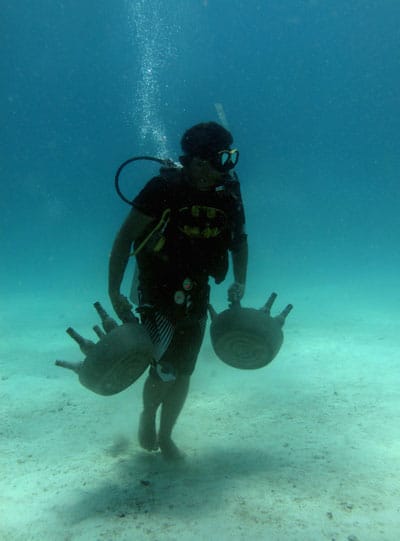
Once the units are in their final position, divers should twist and shake them to allow them to settle slightly into the sand or rubble, this will prevent them from moving around in any large waves or currents. Next, corals can easily be transplanted to the units using marine epoxy. The units are designed to accept both corals from the table nurseries (in which the vinyl tubes are the same diameter as the bottle mouths), and corals of opportunity from the reef. Corals of opportunity are coral fragments that have been created naturally due to fish feeding, waves, and storms but may also be from human-caused disturbances such as diver contact, anchors, boat groundings, or fishing. If these fragments are larger than 10 cm, then it may be best to transfer them directly to the bottle units instead of the nurseries.

Place the coral fragment into the mouth of the bottles or within the matrix of bottles and coral rubble at the surface of the unit, and secure it with a small amount of underwater epoxy. The corals will grow quickly on the inert glass bottles or the dead coral/shells and should colonize the units quite rapidly.
Troubleshooting
The most common problems we have seen with this technique over the years are:
- Making the units too small – If the units are too small, then they are likely to be turned over or displaced during large storms and will not provide a secure location for coral transplanting
- Making units too light – Concrete losses about 40% of its weight in water. If rocks are not added to the concrete, then it will be too light and can be displaced in storms, potentially causing more damage to the existing reef
- Units are not strong enough and crack or break– the units may crack and break if the concrete is not mixed in the correct proportions, is not given enough time to cure, or is not reinforced with metal rebar or wire
- Units sink into the sand – the units are not designed for very soft sediment areas or sandy areas that have strong hydrological action; using them in such places might prove futile as they are denser then the surrounding substrate and will tend to sink over time.
A note from Conservation Diver
We hope that you experiment with this technique and that it proves valuable to your program. Remember that coral restoration is a process that should only be undertaken by those who have had training in the techniques and thoroughly understand and are familiar with the reef they are working in. Every coral restoration technique is different, and some will be more or less successful in different areas at different times. Please let us know what you think about this technique by emailing us at info@conservationdiver.com.
To download this article as a PDF, click here
Reef Restoration Review: Breeze Blocks
Are breeze blocks and effective tool in coral reef restoration? In our previous articles we have always said no, but as this technique continues to be used and even expanded in many reef restoration projects in places like Thailand, we wanted to take a closer a look at it and talk with some other experts to see what they think. The technique is quite simple, and the materials are cheap and readily available, which are both very important qualities for the large-scale implementation of any coral restoration method, and thus deserves a closer look.
How the breeze block technique is used
Breeze blocks, also known as cinder blocks, are a low density, aerated concrete product designed for non-load bearing applications in home and building construction. They are designed to be light, easy to cut to size, and cheap. Each block weighs just 8 kg or less, and costs between 3-6 Thai Baht ($0.01-0.02 USD). Generally, when used in coral restoration, small fragments of coral are affixed directly to the blocks using epoxy or cement. In more elaborate projects, holes are drilled or punched into the block and the coral is glued into it, or in some cases PVC or steel is first affixed, and then the coral fragments. Generally, between 2 and 6 corals are secured to each block, and then the blocks are set down as a sort of pavement at the restoration site. The technique is quick and cheap, and is attractive to reef managers that are looking to create large projects in a short amount of time. But, are these types of projects usually successful?
Effectiveness of Breeze blocks in restoration
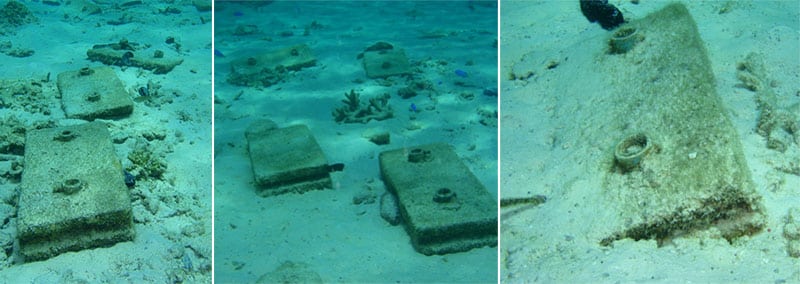
here at Conservation Diver, we have long been critics of this technique for several reasons, mainly that the blocks are too light to provide an effective substrate for long-term coral survival, and that they are unattractive, and tend to either move around in the waves or sink beneath the sands. The blocks, which weigh only 8 kg on land, lose about 40% of their weight in water, and due to their high surface area and low density make them unstable for long-term coral growth. We first witnessed this back in 2006, with the complete destruction of such a project on Koh Tao that was put down in 2005 by the Koh Tao Dive Operators Club in the vicinity of Sai Nuan at a depth of approximately 3-4 meters. After only 1 year, none of the corals on the blocks had survived.
The second reason why we were critical of this technique is that the resulting pavement-like reef that is created does not mimic a natural reef in structural complexity or 3-dimesnional relief. The resulting reef has little to no vertical profile, does not provide diverse habitat for symbiotic reef fishes, and is prone to smothering by sediment and moving sands. Furthermore, depending on the manufacturer, these blocks often contain a high percentage of fly-ash, which depending on the source, can contain dangerous levels of heavy metals or other toxic contaminants whihc limit coral growth or can even contribute to coral disease.
Even though these were our experiences and our assumptions, we could not effectively evaluate this technique as there are very few scientific reports available on the successes or failures of the method, and we do not imply this technique in any of our programs around the world. Online searches through the scientific literature, grey literature, and google images yielded many articles and pictures of the reefs immediately after deployment, but no follow-up reports could be found, which we felt was a major red flag. If people were only posting their nice pictures of the projects immediately after deployment but not years later, then we assumed they all must have failed, just like the ones we were familiar with.
Positive experiences with the Breeze blocks in restoration

Although there are very few scientific reviews of the technique, the ones we were able to find showed a different story to the one we had been telling our students for over a decade. The first example comes from Maiton Island, off of Phuket Island in Thailand, in a project done by Dr. Nalinee Thongtham, and was published as a case study in the CCRES Reef Restoration Manual. The pictures of the project show great success after more than 10 years, with the blocks well covered in small corals from a variety of genera and species. However, this project differed from many of the ‘mainstream’ projects we evaluated in that the blocks used were the largest size available, and no fragments were transplanted to them, they were just left to receive coral recruits naturally. When reached for comment, Dr. Thongtham said “I just provided hard substrate for natural coral larvae to attach and grow naturally. Coral transplantation is not necessary in this area. . .There is no standard restoration method that is effective for all reefs. Different restoration methods can be used and applied to different environmental conditions. For example, providing hard substrate for coral larvae is a suitable method in areas where coral larvae are available but there is no hard substrate for them to grow."
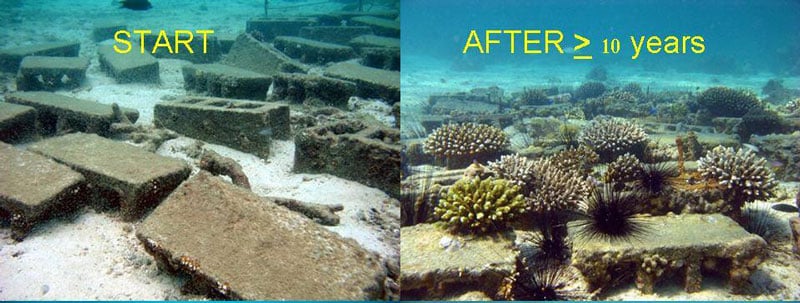
The second published review of this technique which we found was in a 2012 paper by Young et al. and looked at the technique’s application for restoring branching Acropora in the Caribbean. Not much detail is given on the depth, location, or details of the method used, but their findings regarding the use of cinder blocks was considered overall positive, even though in some cases 12-56% mortality was experienced in the first month, and one project experienced 80% mortality following a hurricane. They reviewed 7 projects in Florida which used cement blocks, and the authors’ conclusion was that the coral fragments transplanted had “positive growth rates, low mortality, and were capable of sexual reproduction.” The problems they identified were “accumulation of sediment and macroalgae, susceptible to storm damage, and epoxy failure.”
We also spoke with Mr. Niphon Phongsuwan, Specialist on Marine and Coastal Ecosystem Research for the Thailand Department of Marine and Coastal Resources, who has over 20 years of experience with coral restoration. He provided photographs of a more ‘traditional’ cement block project on Koh Racha. The pictures show a high survival rate of the fragments, and a low incidence of sedimentation or movement of the blocks. Mr. Niphon stated that when using 'the breeze blocks, the place must be deep enough (I recommend deeper than 5 m and never work at the wave exposed site or strong current site). At [Koh] Racha the depth is about 8m so the blocks have no impact from waves."
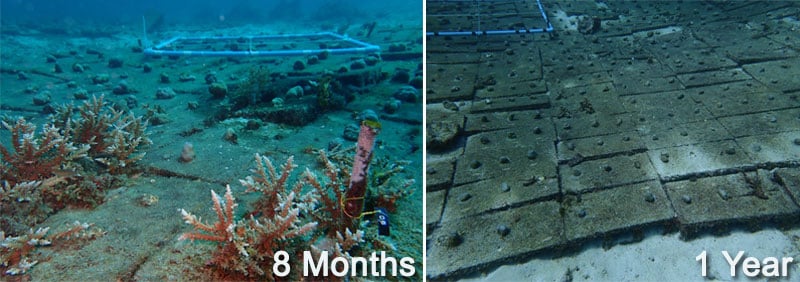
Concerns about breeze blocks for coral restoration
We also talked to some experts who opposed the use of the breeze blocks, for several reasons. When we contacted Dr. James True who has extensive experience with coral restoration in Australia, Hong Kong, and Thailand, he said “My feeling is that (of the many potential concrete-based solutions) breeze blocks are the least effective substrate alternative. Even threaded together by lengths of rebar, they are prone to displacement, shattering & burial by wave action. Railway ties, molded modules, pipe clusters, even power poles or the typical fisheries hollow box elements are all more stable and provide better long-term alternative substrate. As mats, they provide no vertical relief, no complexity and no hydrological advantage over sand.”
When we asked Spencer Arnold, the director and designer of artificial reefs for Conservation Diver, he said that he preferred purpose-built structures which provide more complexity and act as a better habitat for reef organisms, and also are more attractive to divers. He went on to state that “from an aesthetic perspective, cinder blocks as an artificial reef design hold all the appeal of a parking lot. If you like parking lots, you'll love a cinder block reefs.”

The method of coral transplantation and propagation also plays a major role in the long-term success of such projects, and is something we are always highly cognizant of in our restoration efforts. Previously, we have strongly spoken out against programs that rely on asexual propagation and the use of donor corals for the reduction they cause in genetic variability and thus the resilience of the restored reefs. This was also mentioned by Dr. Thongtham, who stared that “genetic diversity is a major key to sustainability of coral reef restoration. As shown from our study during a mass bleaching in 2010, high mortality of transplanted corals occurred in areas where mother colonies were used while in areas where there were natural recruits, most of the coral recovered very well.” Indicating that it may not be that the technique is inherently good or bad, but like most things, that it all depends on how it is applied.
Conclusions
For over a decade we strongly opposed this technique for coral restoration, and instead focused our efforts on using stronger, heavier, and more structurally diverse artificial substrates when replacing lost structure or expanding reefs through our global projects. However, that may have been a slightly draconian view to adopt, as indicated by the limited sucess and positive experiences of others while using this technique. However, in saying that, we must stress the caveat that this technique should be used carefully, as it will not be successful in all applications. Based on the case studies and our experiences, we would recommend only using this technique if the following consideration are met:
- The blocks should only be used in areas where there is little to no wave action or likelihood of large storms (ie sheltered bays, deep areas), and where sedimentation is not a major issue.
- The blocks should ideally be used in conjunction with other structures which provide complexity and habitat to fishes and other reef organisms, many of which are symbiotic and essential to healthy coral growth and reef development.
- Care should be taken when removing corals from the sea for attachment, and methods which do not require removing the corals from the water are generally preferred.
- If using prefabricated breeze blocks and other types of low density or aerated concrete, the largest size should be selected, and efforts should be made to consolidate them or lock them in place to reduce storm related mortality.
- Coral propagation (asexual fragmentation) and the use of donor corals is never advised, as the long-term genetic effects lead to reduced resilience and survival through mechanisms such as genetic bottlenecking, inbreeding depressions, and reduced reproductive success.
In our programs, we will continue to use other techniques, and see very little reason to use cinder blocks when so many better materials and designs are readily available. However, after talking with more experts we recognize that there is a place for these techniques, and for programs using unskilled volunteers and working with limited budgets this technique can be useful in building community awareness, involving a wide range of stakeholders.
Helping to assess reefs around the globe
The programs and courses offered by Conservation Diver were originally developed alongside local reef managers in an effort to increase the effectiveness and financial sustainability of their valuable work. Increasingly, the protocols and techniques developed under the Conservation Diver syllabus have been applied to promote or improve conservation strategies at various scales in several countries, such as to assess reefs in areas of need.
Last month, research director Rahul Mehrotra and a team of Conservation Divers published their third study, in which skills taught through our courses were applied to promote informed conservation decisions. This time assessments were requested by the government of the Escalante region of the Philippines, including a Marine Protected Area (MPA) that was established 15 years prior. This is the third such expedition Rahul and the team have undertaken and published, and is invaluable for the local governments to assess the actions already taken, and direct the policies that will decide the future fate of the areas and their resources.
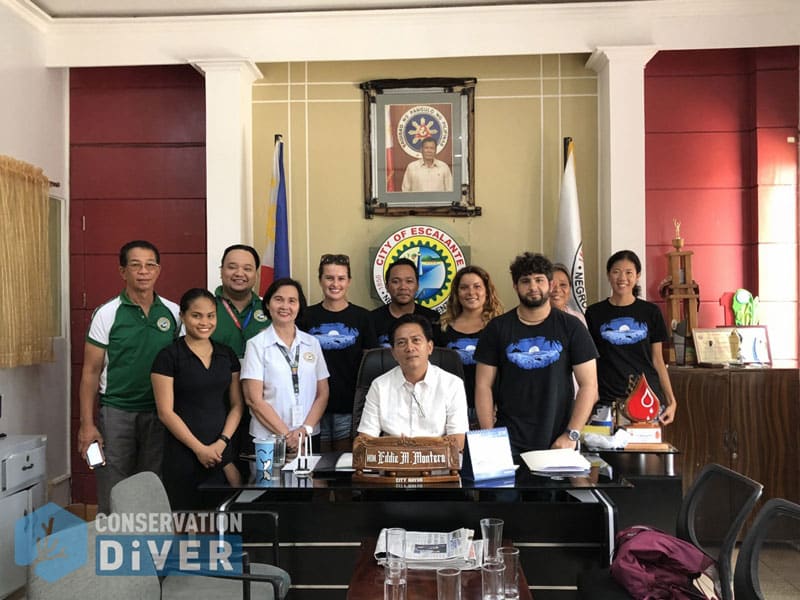
The project was supported and carried out in collaboration with our partners at the Love Wildlife Foundation and the University of the Philippines, Cebu. The researchers involved were all trained and certified in Conservation Diver monitoring and data collection techniques, and were thus more than proficient and prepared for the job at hand. Most of the surveys were carried out using SCUBA equipment while diving in coral reef and muck habitats, but additional surveys were also carried out by snorkeling in mangroves and sea grass beds, and by visiting local fish markets.
The team was able to identify and record more than 700 species during the surveys in Escalante, including 191 species of fish, 227 species of cnidarians (corals and related animals), 120 species of mollusks, 58 species of echinoderms , 40 species of crustaceans, and 27 species from the Platyhelminthes phylum (flatworms and their relatives). These findings provide indications that the marine habitats of the area are highly biodiverse, but evidence was also provided showing that they are in dire need of increased protection and enforcement of existing regulations.
Hard coral cover was generally considered ‘fair’ (as most of the country’s reefs were in previous studies), ranging from 16%-66%, with most sites surveyed having coverage greater than 30%. The team was also excited to record coral spawning during the surveys, observing gamete bundles released from both Montipora and Lobophyllia on March 7th. They then witnessed sea urchins and clams spawning during a daytime in a mass event occurring one week later, on March 14th.
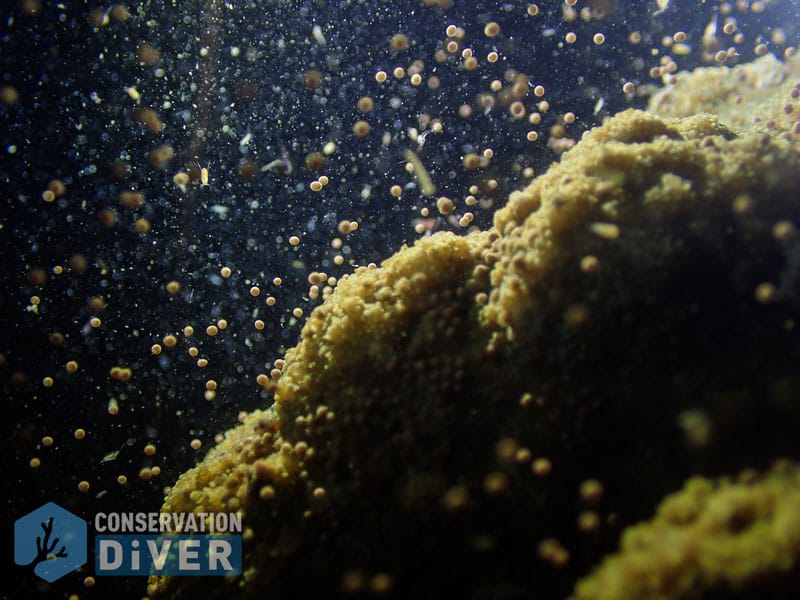
The data collected during all the various surveys was used to write a report in order to advise policy changes for the local government. Those changes included zoning to protect the most valuable areas, but still allow for regulated commercial use in order to sustain local economies and livelihoods. It was recognized by the authors that the current MPA’s regulations and enforcement make it ineffective at achieving the original goals as set out 15 years ago. The paper recommended broader participation in decision making and enforcement of the regulations, requiring more stakeholder education and participation. The team also recommended some areas be designated for responsible tourism in order to provide alternative, non-extractive revenue streams for the local communities. Lastly, the authors recommended infrastructure additions such as mooring lines to reduce incidences of anchor damage to the delicate reefs.

This study is something which we at Conservation Diver are quite proud of, not only for its potential impact on policy and sustainability of the reefs in the region, but as a proof of concept of our training system. The thousands of certified students that have been through our programs are proof that there is demand for this type of training; and our success on the local scale, such as on the island of Koh Tao, has proven that we are able to make a tangible difference through the active participation of trained divers as well as create sustainable funding streams to ensure the success of long-term monitoring, protection, and restoration projects. But this expedition in particular also shows that there is a wider application to our methods and techniques that can be utilized to advise governments around the world to make science-based decisions uniquely established for their region, local communities, and customs. We hope to send out more teams on expeditions like this in the future to assess reef health, create more collaborations with local universities and governments, and help to fill in the gaps between those two groups. In doing so, we think that we can create an effective nexus that can realize tangible positive changes in the way that we manage and use our finite reef resources and ensuring that these ecosystems persist and thrive
Download the full report here

A New Species of Coral-Eating Nudibranch
A new species of coralllivorous nudibranch has just been discovered by our friend and colleague, Dr. Rahul Mehrotra. The new species, which he named Phestilla viei, was described in a recent article in the journal Marine Biodiversity, titled “A new species of coral-feeding nudibranch (Mollusca: Gastropoda) from the Gulf of Thailand.” Not only does this paper provide record of this new species, but it also helps to clarify the systematics of the genera, which currently contains 8 coral-feeding species that have been revised several times over the last few decades.

This study was conducted as part of Rahul’s PhD, which has yielded several other impressive firsts for the world of sea slugs, including the observation that there are corals which feed on sea slugs, as well as three other first records of species found from Koh Tao; including Unidentia aliciae in 2019, as well as Arminia occulta and Armina scotti in 2017.
The new species, Phestilla viei, was first found on the island of Koh Tao, Thailand by Conservation Diver board member, Spencer Arnold, who was a co-author on the paper. He found the first individual on a coral of the species Pavona explanulata, a resilient coral species which is becoming more prevalent on the island as it replaces some of the less robust species in the face of climate change and localized anthropogenic stresses. The novel species was named after local nudibranch enthusiast and citizen scientists, Mr. Vie Panyarachun, well known for his vast contributions in recording and curating sea slug records from Thai waters.
After the first observation, Rahul and his team conducted a series of surveys to locate more individuals and evaluate their ecology, anatomy, and genetics. All of the individuals found were on the same species of coral, implying that they are an obligate parasite of the sceleractinian, Pavona. Because of this obligate relationship, the morphology of the nudibranch is such that it closely resembles the coral, making it very difficult to find. Rahul and his co-authors stated in the paper that the easiest way to find them is to actually look for the feeding scars and egg trails, and then to look for the individuals making them.
Another amazing trait which makes this cryptic species so difficult to observe is that it actually ‘steals’ symbiodinium (the unicellular algae which power the coral) and integrates them into their bodies rather than digesting them, in a process termed “kleptosymbiosis.” Although this species is a corallivore, it does not appear to be a major threat to coral populations, as it was never observed to eat the entire coral, and no overpopulations or outbreaks have been documented.
Although this was the first scientific description, observations of the species have been made in other parts of the Western Pacific, including Indonesia, Madagascar, Papua New Guinea, and the Philippines. Now that more divers know about this species, and where to look for it, surely it will be observed in many other countries over the next few years.
After reading the article, we had some questions for Dr. Mehrotra, so we interrupted his work to interview him about his findings and current projects.
Q1: This is a very interesting finding, when did you first become aware of these species, and how did you first spot it?
I came across reference to a similar species in a couple of references, however with very little corresponding information. After finding a paper documenting this from Hong Kong feeding on Pavona decussata, I considered the possibility that we may have this on Koh Tao. The truth is, I simply needed to share this paper with Spencer who used his remarkable skills in a matter of weeks to find a similar species feeding on a different prey at Koh Tao.
Q2:As this is the fourth new species you have described for the region, do you think Koh Tao is a particular hotspot for sea slugs, or do you expect other regions in the Gulf to have similar levels of biodiversity?
This is the fourth species of nudibranch to be described from Koh Tao, which has indeed been the home of much of the sea slug research from Thailand over the past decade. However, our data from other locations suggests that, while Koh Tao does seem to offer a diversity of species distinct from what is commonly found elsewhere in the Gulf, the richness of discoveries is largely due to the focused study in the area. Many places in Thailand appear to host species that are awaiting a closer investigation.
Q3: You named this nudibranch after Mr. Vie Panyarachu, how has he influenced your work over the years, or the status of nudibranchs in Thailand in general?
Vie Panyarachun is a keen recreational diver and naturalist who has played a remarkable role in curating records of sea slug diversity in the country. His work as a citizen scientist has helped create a repository of species as well as playing an active role in sharing the world of sea slugs with the SCUBA diving community in Thailand.
Q4: why do you think it is important that populations of nudibranchs in the region are recorded and monitored?
Nudibranchs and other sea slugs have been shown to play a variety of roles economically and ecologically, however few of these have been investigated thoroughly. Monitoring sea slug diversity has already led to remarkable documentation on the hidden impacts of climate change and species invasions. The importance of monitoring sea slugs in the Western-Pacific, home to the most biodiverse marine environments in the world, allows us to dig deeper into the complex ecology of the region. In a time where hundreds of invertebrate species are known to have been regionally displaced or gone extinct only to be discovered/rediscovered after the fact, detailed monitoring of such understudied groups may allow us to catch large scale threats before they take hold. Many sea slugs have been associated with very specific prey organisms, and thus the fate of any given species is also intricately tied to the resilience of its prey. The species we describe here for example has been found exclusively on a single species of coral, with similar species of coral either hosting their own distinct species of nudibranch, or none at all. Many reef building corals such as the prey of P. viei are susceptible to threats such as coral bleaching. We have little evidence at present to suggest that populations of P. viei would could show enough dietary plasticity to shift hosts to a more resilient prey should these threats escalate.
Q5: What are you currently working on, or towards, regarding sea slugs in Thailand?
I am in the process of completing my work from Koh Tao, documenting further ecologically relevant observations. My work on sea slugs will be transitioning to other fields soon too, so as to provide a more solid framework for further research on sea slug biology in Thailand.
We want to pass our sincerest congratulations to Rahul for this valuable and important work, and wish him all the best in his future ventures, which we follow very closely and support in any way we can. We also want to congratulate Spencer Arnold on his find, and his invaluable assistance to this study, he has an eye for finding tiny sea slugs like no one else. We also want to congratulate Mr. Vei on the species being named for him, and for all his contributions to the field over the years.
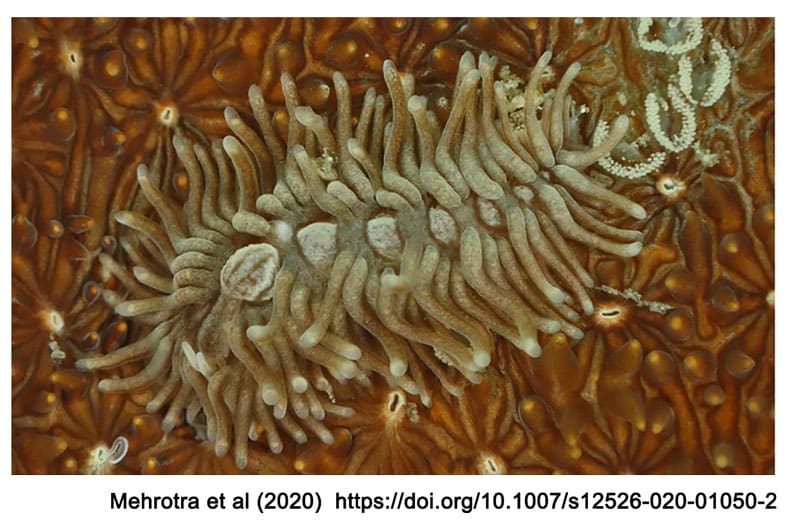
Does coral restoration also enrich fish communities?
When we perform coral restoration activities, the goal is to not only increase the amount of living coral, but to enrich the entire ecosystem, including the fish communities. Restoration programs tend to focus on bringing back living coral, under the idea that by bringing back the foundation of the ecosystem, the rest of the reef organisms will follow. But is that truly the case?
A recent publication headed by Dr. Margaux Hein investigated whether long-term coral restoration programs did in fact bring back fish communities, and the results were not as significant as some restoration practitioners might expect. The study, titled “Effects of coral restoration on fish communities: snapshots of long‐term, multi‐regional responses and implications for practice,” was published in April in the Journal of Restoration Ecology. It analyzed four coral restoration sites, all of which had been ongoing for 8 years or longer, two from the Caribbean and 2 from the Indo-Pacific. The studies where completed in the same locations as her publication on the effectiveness of long-term coral restoration, and builds upon the lessons learned from that study.
The study assumed, like most of the coral restoration industry, that efforts to bring back corals and structure would also attract a wide range of reef fishes, thereby restoring the function and value of the ecosystem. Not only are the corals essential for the survival of the fishes, but the fishes (especially the herbivores and detritivores ones) help to maintain the dominance of corals on the reef over macroalgae. In general, more fish biomass is thought to represent a healthier ecosystem, and also leads to more value for local economies through tourism and fisheries. So, reef restoration efforts should be concerned with the abundance and biodiversity of fish communities when evaluating the effectiveness of their efforts.

In Dr. Hein’s study, she looked to see which of the various restoration methodologies most positively affected fish communities, and hypothesized that locations which had the highest structural complexity of corals would also have the highest abundance and diversity of fishes. She and her team carried out transect surveys for fish at four locations around the globe, and looked at three site types for each location; restored reefs, unrestored reefs (adjacent to and degraded to a similar extent as the restored reefs, but with no actions being implemented), and control reefs (those with little relative degradation and no restoration, but similar in composition). Each location had three replicates per site type, for a total of at least nine replicates per location studied. They categorized reef fishes into three groups by size (small, medium, and large), and by genera.
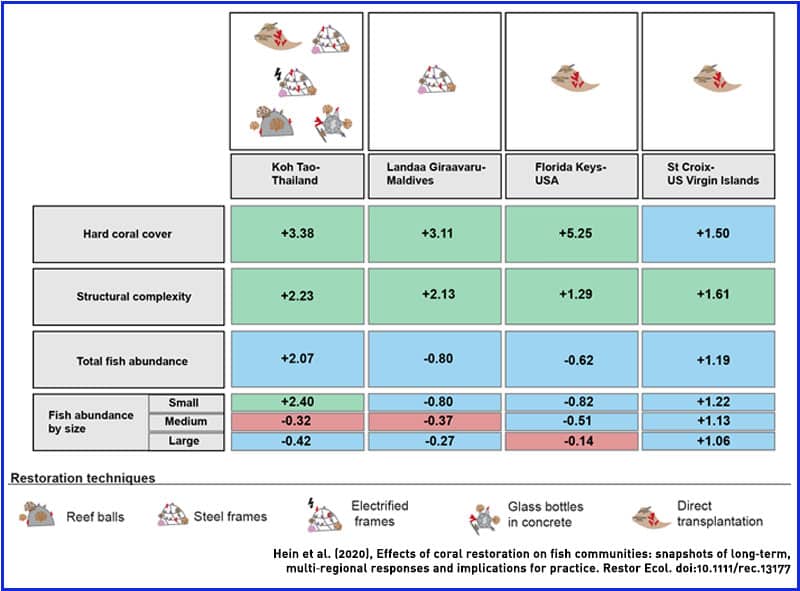
Although in the last study they found significant differences between the coral communities at each location, results regarding the fish communities where far less significant. In fact, only one site, the one at Koh Tao, operated by our partners at the New Heaven Reef Conservation Program, showed any increase in fish biomass or diversity, and it was not statistically significant. At Koh Tao, the restored sites had the most fish, a 2-fold increase, but only among the smaller fishes, and only of the damsel fish family. At other locations, the fish abundance did not vary greatly between sites, and in the Caribbean was actually highest at the control sites (again, not significantly). When it came to medium and large fish, they were generally lower in the restored sites than the unrestored or control sites.
The study went on to point out that, on Koh Tao, a variety of methods where utilized, including transplanting corals to the natural reef as well as to artificial substrates, whereas at all the other locations only one strategy was utilized. Thus, interning again that taking a holistic approach to restoration may be preferred over focusing all time and resources to just one method, as in the other programs assessed. By increasing the structural diversity and available habitat on the reef through the creation of artificial reef structures while also increasing the amount of living coral on natural reef areas more consistent benefits are realized.
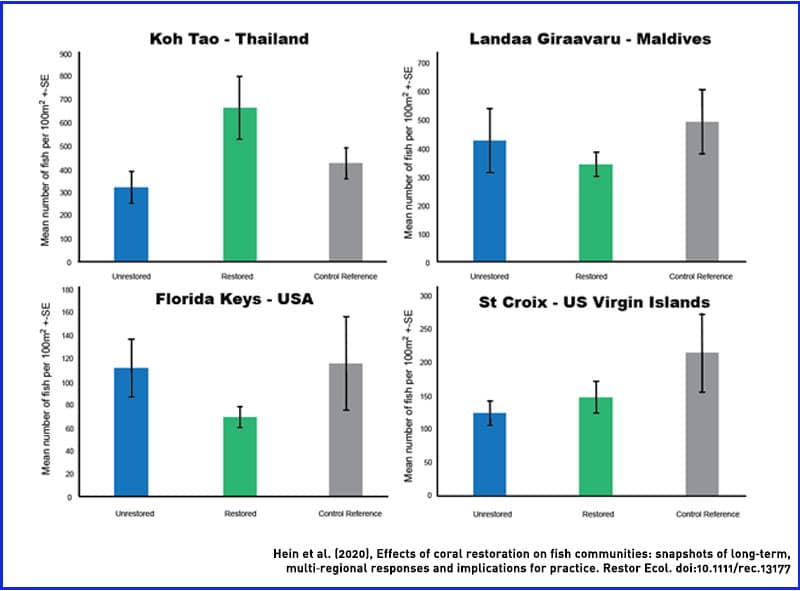
In the end, the study did not find significant differences in fish community biomass and diversity, contrary to the original hypothesis. The authors discussed possible reasons for this, and gave recommendations to future studies and restoration programs for improvement. The study concluded that:
“Coral restoration efforts aiming at increasing fish abundance and diversity on degraded reefs should strive to substantially increase both coral cover and structural complexity by maximizing coral diversity, and use a diverse set of artificial transplantation substrata where possible. Importantly, there is likely no “one size fits all” approach to restoration when it comes to maximizing the response of fish communities. Rather, to realize such a goal requires a location-specific understanding of the community, that will need to be incorporated at all stages of the design of the restoration efforts, from site-selection, planting design and monitoring regime. “
We at Conservation Diver wanted to know a little bit more about what Dr. Hein felt was the most vital aspects to coral restoration, as she has published many studies on the various aspects of it, and has visited many reef restoration programs around the world, here is what she said:
Q1: Your study found that there was little in the way of significant improvements at the restored sites at all of the locations studied, despite the hypothesis to the opposite. What do you think are the main things that restoration is missing that would improve fish abundance and biodiversity?
The limited response of fish to restoration I observed might very well be due to my study-design and the fact that I only got a “snapshot” of what fish population looked like at each location, with a one-off survey. Fish move (haha), so properly documenting their response to restoration would require repeated surveys from the very beginning of the restoration efforts. Still, I think there are ways in which coral restoration programs could be better designed to improve fish abundance and diversity:
1. Site selection should be based on local knowledge of fish communities’ dynamics and connectivity
2. Restoration designs should maximize 3-dimensional structural complexity
3. Restoration designs should improve coral diversity
Q2: Since you have dived at many different artificial reefs/restoration projects around the globe, what technique do you think works best to attract a diverse population of fishes?
I think the key is habitat structural complexity and diversity. Fish are attracted to places for food and shelter, and complex structures provides refuges of different sizes as well as diverse feeding surfaces. Maximizing habitat complexity can be done by adding artificial structures and maximizing coral diversity.
Then obviously, site selection is very important, making sure that the restored area is somehow connected to healthy fish populations – the ideal scenario being for the restored sites to be within no-take marine protected areas. The more the restoration efforts can be integrated within resilience-based management, the better success we’re likely to see in the long-term.
Q3: Which fishes do you think are most important to attempt to attract when planning a restoration project?
That’s a tricky question- I think it all depends on the initial goals of the project. If initial goals are focused on enhancing fish nursery habitat for local fishermen, then it’s important to specifically look at the response of fish species that are important for these fisheries. These may have specific food and shelter requirements that the restoration efforts can accommodate. If initial goals are focused on restoring ecological function and resilience, then we need to look at the response of functionally important fish species and restoring key ecological processes such as herbivory. These goals are not necessarily mutually exclusive, but better defining goals is important when planning and designing restoration efforts.
Q4: You have now written several papers and book chapters on coral reef restoration, what are the main lessons you have learned, that you think the industry needs to heed in order to be more successful in the future?
I would say that the most important lesson I have learned is that there is a lot more to coral restoration than growing and planting corals. In particular, it can be a useful educational tool that encourages tangible behavioral changes and improves the social resilience of local communities as well as the ecological resilience of the reef. But there is no “one size fits all” approach. To be successful it needs to be carefully planned and designed against specific long-term goals, integrate stakeholder engagement, and most importantly be integrated within a greater reef management plan that act on stressors such as MPAs, water quality and predator control, and the obvious elephant in the room: climate change.
We want to wish our sincerest congratulations to Dr. Margaux Hein for this valuable and encouraging study, and also a big congratulations to her co-author, and our board member Eloise "Elle" Haskin, on her first scientific publication! Surely many more are to come.
Also be sure to check out what Dr. Hein is currently working on by checking out her marine restoration and consultancy company website.


